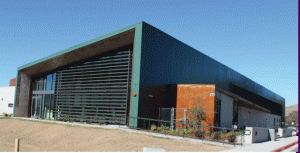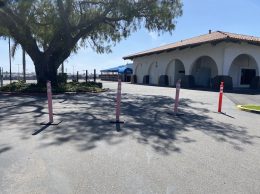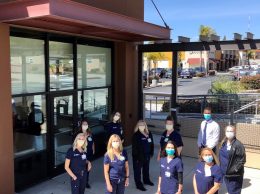
The 40 Prado Homeless Services Center in San Luis Obispo.
The homeless population of San Luis Obispo County is expanding rapidly, and the high cost of housing is making it difficult to attract the medical and mental health care providers needed to serve the burgeoning population.
The homeless person count on a single day in 2019 in San Luis Obispo County increased by 32 percent compared to 2017 numbers, according to a report released by the county’s department of social services.
The point-in-time count identified 1,483 homeless people in the county. Only two year-round shelters exist in the county, and they account for just 150 beds.
A rise in the homeless ranks in SLO County comes as Santa Barbara County’s homeless population is shrinking and Ventura County is seeing a 45 percent rise with housing affordability as a common issue across the Tri-Counties.
The homeless surge places greater stress on medical services in the region, even on the private side as emergency rooms have daily encounters with homeless people seeking services usually fulfilled by a primary care provider or behavioral health facility.
Emergency departments are dealing with an increasing number of patients coming in with mental health issues, said French Hospital Medical Center CEO Alan Iftiniuk. “That’s not the ideal place — we’re not set up for it.”
They do not have the resources psychiatric hospitals do and behavioral health needs are not better serviced in outpatient settings, he said, adding that “because of the lack of county resources, we’re just being forced to do that because there’s little other alternative.”
In SLO, the county is responsible for providing mental and behavioral health services to homeless people, a service that Health Agency Director Michael Hill said is already operating at capacity, along with non-profits, and any increase in population is going to increase the burden on the service providers, he said.
Behavioral health services for the homeless are most scarce.
Grace McIntosh, deputy director of nonprofit Community Action Partnership of SLO, said a lack of specialized care for mental health needs is the biggest problem.
“We don’t have the resources,” she said.
The county only has 16 beds for its psychiatric health facility.
“They are significantly impacted,” McIntosh said.
The county gets help through Medi-Cal for providing psychiatric care to the homeless, but the budget is pushing its limits, Hill said.
“The system right now is burdened and part of that has to do with the struggle to attract providers to the area,” he said.
At the core of the issue is a housing affordability crisis in the county. Annual wages are 8.5 percent of the median sales price for housing at approximately $50,000, according to the Bureau of Labor Statistics.
The Recuperative Care Program CenCal implemented on the Central Coast in February emphasizes coordination for permanent housing in order to relieve costly expenses hospitals face due to recurring emergency room visits and hospital readmissions.
CenCal CEO Bob Freeman said housing is an integral part of breaking the cycle of high utilizers who are continuously admitted, discharged, and back on the streets only to end up in the hospital again.
Hospitals with high readmission rates could potentially see an effect on their bottom line as the Centers for Medicaid and Medicare Services reduce payments to hospitals with excess readmissions.
Nevertheless, “It’s near to impossible to place homeless individuals,” said Sylvia Barnard, executive director of Good Samaritan Shelter in Santa Maria.
Longer-term medical respite such as housing is one of the largest existing gaps for homeless individuals, “but you just cannot build your way out of it,” she said.
Scott Smith, executive director of the SLO Housing Authority, echoed Barnard’s sentiment, adding, “It’s a supply and demand problem, you would think that if you increase the supply enough, prices would go down — that’s not the case.”
Because of housing unaffordability, recruiting people to fill health care jobs in the region is also a major issue, according to Smith.
He said people are looking for buying power that SLO cannot currently offer.
“The gap between median incomes and median sales prices is inordinate,” he said.
For homeless individuals looking to move into stable housing, it’s slim pickings for the number of affordable housing units. A low turnover rate means an individual has to make three times the amount of rent to afford the unit without housing subsidies.
• Contact Veronica Graff at vgraff@pacbiztimes.com.






 Print
Print Email
Email

















